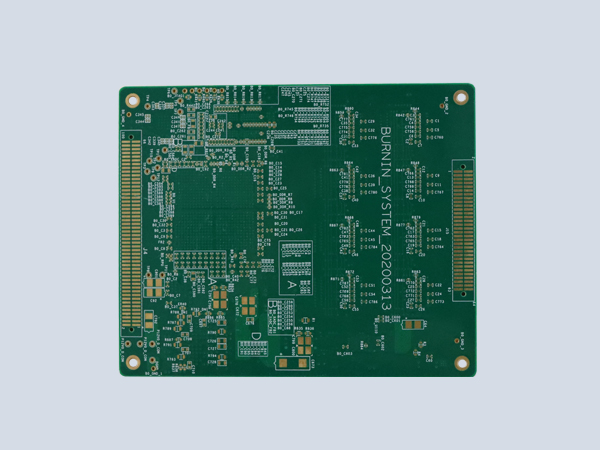24 - layer PCB circuit board
Discover the 24 - layer PCB circuit board, a high - end and advanced solution in the world of printed circuit boards. With its remarkable 24 - layer construction, this PCB offers unparalleled capabilities and flexibility. Engineered for applications that demand the utmost in complexity, high - speed data transfer, and superior performance, it is the go - to choice for industries such as aerospace, high - performance computing, and advanced telecommunications. Whether you're developing cutting - edge satellites, next - generation servers, or high - speed networking equipment, the 24 - layer PCB circuit board can meet and exceed your expectations.
Product Description
- Twenty - Four - Layer Configuration
- Abundant Routing Space: The 24 - layer structure provides an incredibly vast amount of routing space. This allows for the implementation of highly intricate circuitry, which is essential for applications with high - density interconnect requirements. Designers can precisely route signals and power lines, minimizing interference and maximizing signal integrity. For example, in high - performance computing systems, where numerous components need to communicate at high speeds, the extensive routing space enables the creation of efficient signal paths between processors, memory modules, and other critical components.
- Enhanced Signal Isolation: With so many layers, it becomes possible to effectively separate different types of signals. Power planes can be carefully sandwiched between signal layers, providing stable power distribution while isolating signals from power - related noise. This is crucial in applications like aerospace electronics, where sensitive avionics systems must operate in a noisy electromagnetic environment. By isolating signals, the 24 - layer PCB ensures reliable and accurate data transmission.
- Increased Component Integration: The additional layers enable more components to be integrated onto a single board. This not only leads to more compact designs but also reduces the need for external connectors and cables, which can introduce signal degradation. In advanced telecommunications equipment, such as 5G base stations, the ability to integrate more components on a single 24 - layer PCB simplifies the overall system architecture and improves its performance.
- High - Speed Data Transfer Capability
- Optimized for High - Frequency Signals: The 24 - layer PCB is designed to handle high - frequency signals with ease. Its construction allows for the implementation of controlled - impedance traces, which are essential for maintaining signal integrity at high data rates. In high - speed networking applications, where data transfer rates can reach several gigabits per second, the PCB's design ensures that signals can travel long distances across the board without significant loss or distortion.
- Minimal Signal Delay: The carefully engineered layer stack - up of the 24 - layer PCB helps to minimize signal delay. This is crucial in applications where real - time data processing is required, such as in radar systems or high - speed trading platforms. By reducing signal delay, the PCB enables faster response times and more efficient data processing.
- Applications
- Aerospace Industry: In aerospace, the 24 - layer PCB is used in a variety of applications, including avionics systems, satellite communication equipment, and flight control systems. The board's ability to handle complex circuitry, withstand harsh environmental conditions (such as extreme temperatures and vibrations), and provide reliable performance is essential for the safety and functionality of aircraft and spacecraft.
- High - Performance Computing: High - end servers and supercomputers rely on 24 - layer PCBs to support the high - speed data transfer and complex processing requirements of multiple processors, large amounts of memory, and high - bandwidth storage devices. The PCB's ability to integrate numerous components and provide excellent signal integrity is crucial for achieving maximum computing performance.
- Advanced Telecommunications: In the field of telecommunications, 24 - layer PCBs are used in 5G base stations, fiber - optic communication equipment, and high - speed routers. These applications require high - density interconnects, high - speed data transfer, and reliable operation to meet the growing demand for faster and more reliable communication networks.
- Reliability and Quality
- Top - Quality Materials: The 24 - layer PCB is constructed using high - quality materials that are selected for their excellent electrical, mechanical, and thermal properties. The laminates used in the board are designed to withstand high temperatures and provide good insulation, while the copper traces are of high purity to ensure low resistance and reliable electrical conductivity.
- Stringent Quality Control: The manufacturing process of the 24 - layer PCB involves strict quality control measures. Each layer is precisely fabricated and inspected to ensure accurate circuitry placement. The board undergoes comprehensive electrical testing, including impedance testing, continuity testing, and signal integrity analysis. Mechanical tests are also conducted to ensure that the PCB can withstand normal handling, installation, and environmental stress. These rigorous quality control procedures guarantee that the PCB meets the highest industry standards.
- Customization Options
- Tailored to Specific Needs: Manufacturers offer a wide range of customization options for the 24 - layer PCB. Whether you need specific component placements to fit a unique form - factor, additional layers for more complex functions, or customized routing designs to optimize performance for your application, the PCB can be tailored to your exact requirements. This flexibility allows you to create a PCB that is perfectly suited to your specific product, whether it's a new aerospace prototype or an advanced telecommunications device.







